lock KIA PICANTO 2006 User Guide
[x] Cancel search | Manufacturer: KIA, Model Year: 2006, Model line: PICANTO, Model: KIA PICANTO 2006Pages: 281, PDF Size: 9.89 MB
Page 24 of 281
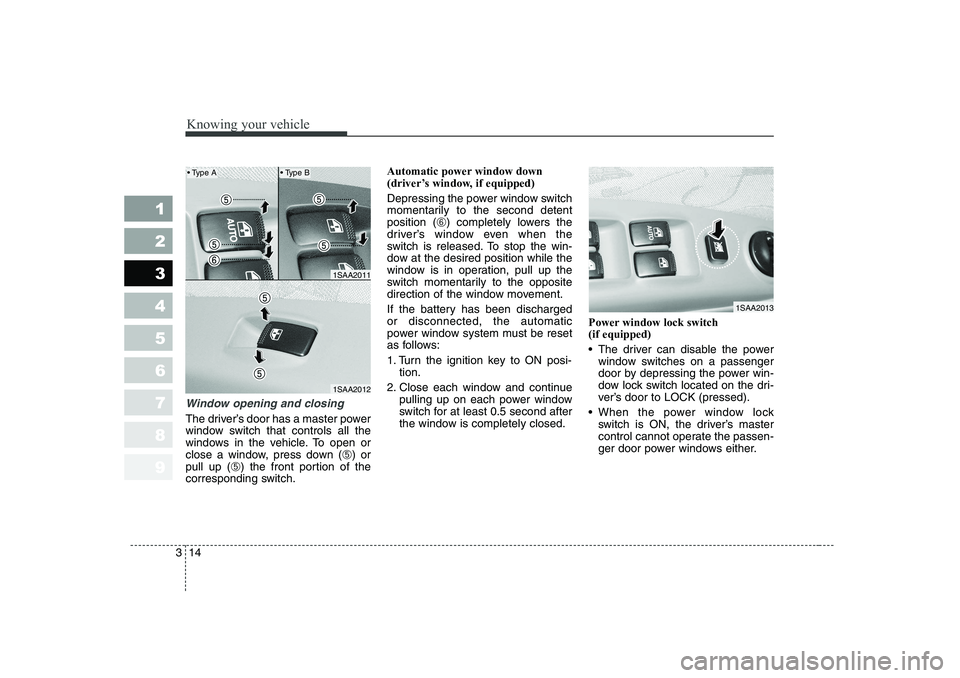
Knowing your vehicle
14
3
1 23456789
Window opening and closing
The driver’s door has a master power
window switch that controls all the
windows in the vehicle. To open or
close a window, press down (
➄) or
pull up ( ➄) the front portion of the
corresponding switch. Automatic power window down
(driver’s window, if equipped)
Depressing the power window switch
momentarily to the second detentposition (
➅) completely lowers the
driver’s window even when the
switch is released. To stop the win-
dow at the desired position while the
window is in operation, pull up the
switch momentarily to the opposite
direction of the window movement.
If the battery has been discharged or disconnected, the automatic
power window system must be reset
as follows:
1. Turn the ignition key to ON posi- tion.
2. Close each window and continue pulling up on each power window
switch for at least 0.5 second after
the window is completely closed. Power window lock switch (if equipped)
The driver can disable the power
window switches on a passenger
door by depressing the power win-
dow lock switch located on the dri-
ver’s door to LOCK (pressed).
When the power window lock switch is ON, the driver’s master
control cannot operate the passen-
ger door power windows either.
1SAA2012
1SAA2011
Type A Type B
1SAA2013
Page 25 of 281
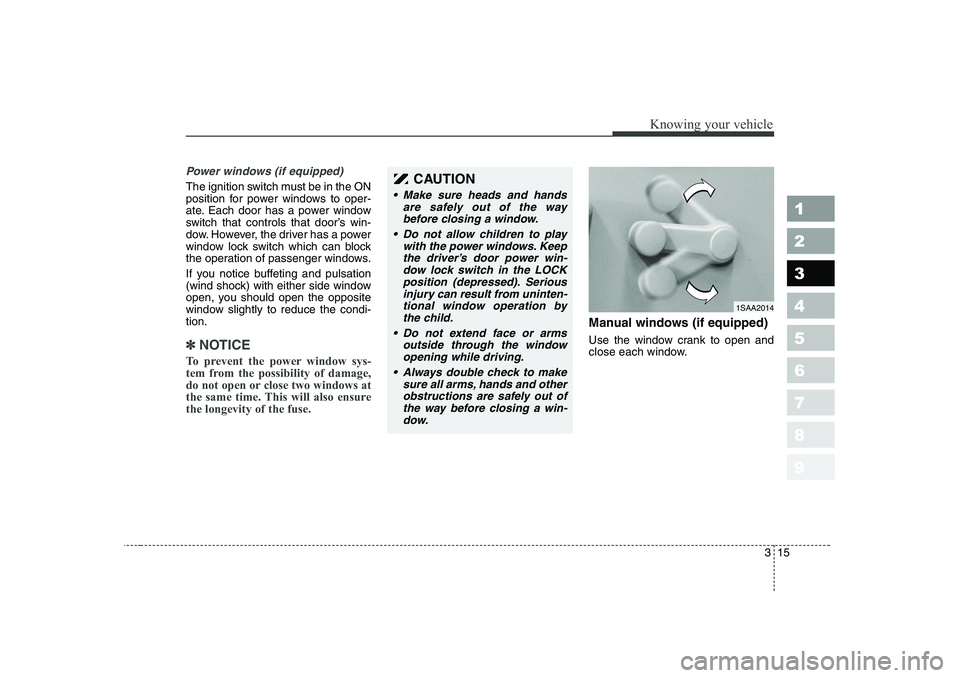
315
1 23456789
Knowing your vehicle
Power windows (if equipped)
The ignition switch must be in the ON
position for power windows to oper-
ate. Each door has a power window
switch that controls that door’s win-
dow. However, the driver has a power
window lock switch which can block
the operation of passenger windows.
If you notice buffeting and pulsation
(wind shock) with either side window
open, you should open the opposite
window slightly to reduce the condi-tion.
✽✽NOTICE
To prevent the power window sys-
tem from the possibility of damage,
do not open or close two windows at
the same time. This will also ensurethe longevity of the fuse.
Manual windows (if equipped)
Use the window crank to open and
close each window.
CAUTION
Make sure heads and hands are safely out of the waybefore closing a window.
Do not allow children to play with the power windows. Keepthe driver’s door power win-dow lock switch in the LOCK position (depressed). Seriousinjury can result from uninten-tional window operation by the child.
Do not extend face or arms outside through the windowopening while driving.
Always double check to make sure all arms, hands and otherobstructions are safely out of the way before closing a win-dow.
1SAA2014
Page 27 of 281
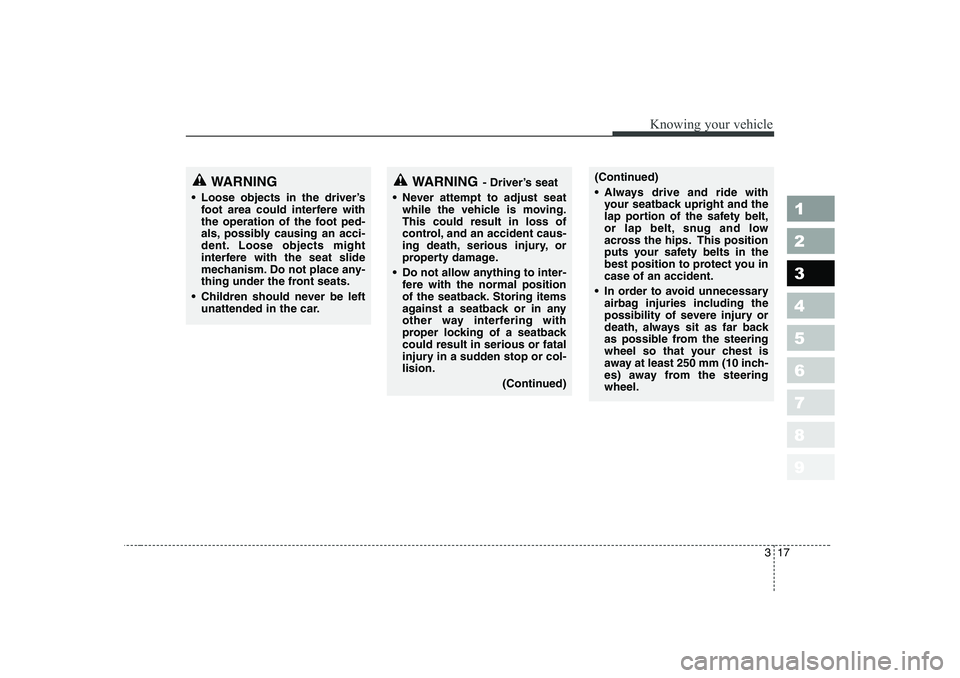
317
1 23456789
Knowing your vehicle
(Continued)
Always drive and ride withyour seatback upright and the
lap portion of the safety belt,
or lap belt, snug and low
across the hips. This position
puts your safety belts in the
best position to protect you incase of an accident.
In order to avoid unnecessary airbag injuries including the
possibility of severe injury or
death, always sit as far back
as possible from the steering
wheel so that your chest is
away at least 250 mm (10 inch-
es) away from the steeringwheel.WARNING
Loose objects in the driver’s foot area could interfere with
the operation of the foot ped-
als, possibly causing an acci-
dent. Loose objects might
interfere with the seat slide
mechanism. Do not place any-
thing under the front seats.
Children should never be left unattended in the car.WARNING - Driver’s seat
Never attempt to adjust seat while the vehicle is moving. This could result in loss of
control, and an accident caus-
ing death, serious injury, or
property damage.
Do not allow anything to inter- fere with the normal position
of the seatback. Storing items
against a seatback or in any
other way interfering with
proper locking of a seatbackcould result in serious or fatal
injury in a sudden stop or col-lision.
(Continued)
Page 28 of 281
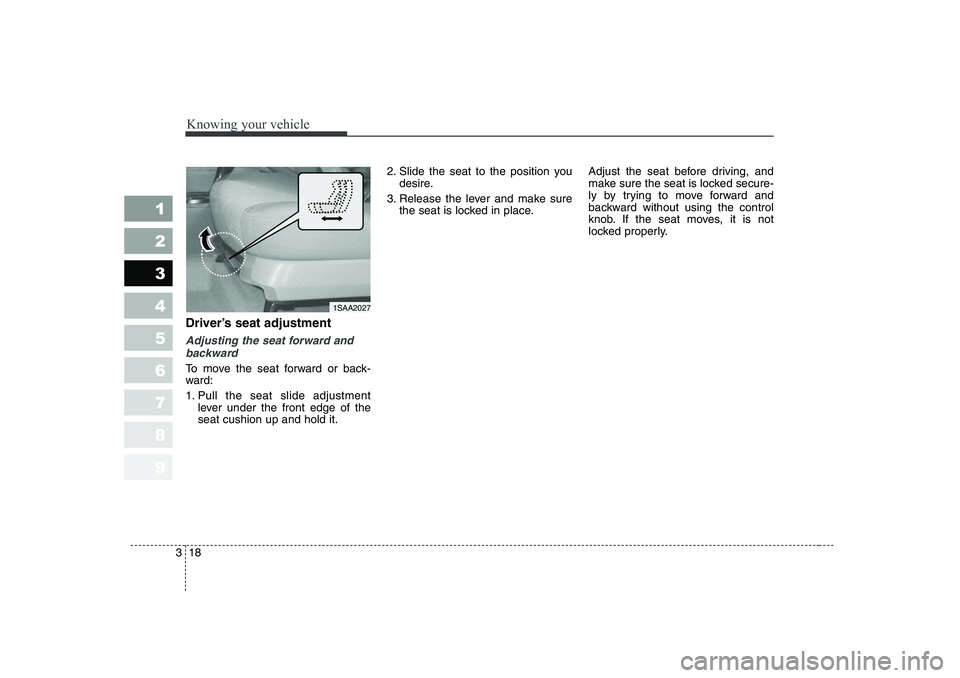
Knowing your vehicle
18
3
1 23456789
Driver’s seat adjustment
Adjusting the seat forward and
backward
To move the seat forward or back-
ward:
1. Pull the seat slide adjustment lever under the front edge of the seat cushion up and hold it. 2. Slide the seat to the position you
desire.
3. Release the lever and make sure the seat is locked in place. Adjust the seat before driving, and
make sure the seat is locked secure-
ly by trying to move forward and
backward without using the control
knob. If the seat moves, it is not
locked properly.
1SAA2027
Page 29 of 281
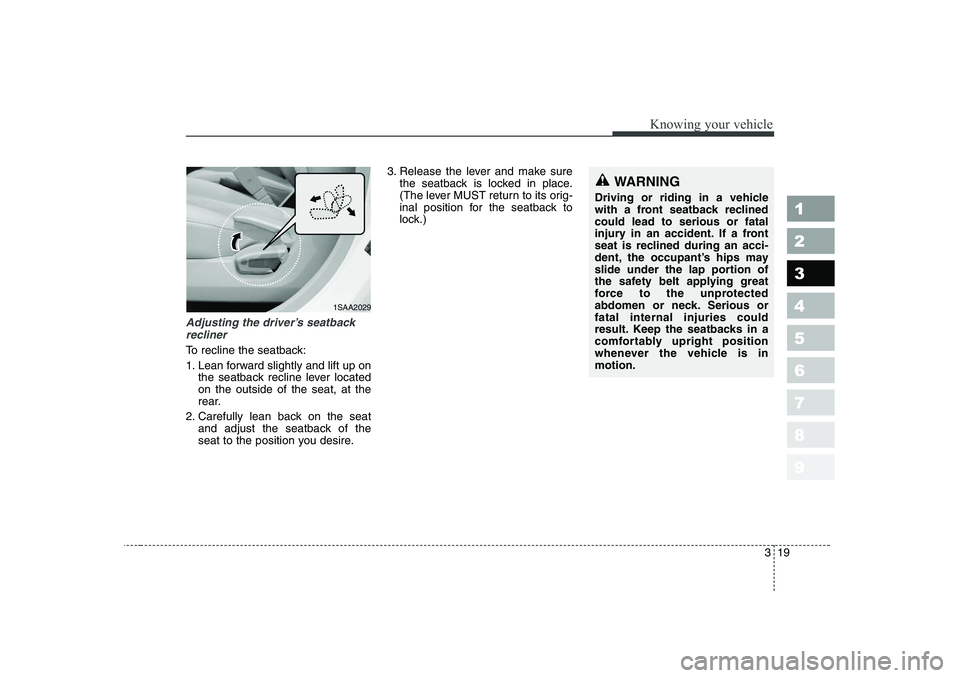
319
1 23456789
Knowing your vehicle
Adjusting the driver’s seatbackrecliner
To recline the seatback:
1. Lean forward slightly and lift up on the seatback recline lever located on the outside of the seat, at the
rear.
2. Carefully lean back on the seat and adjust the seatback of the
seat to the position you desire. 3. Release the lever and make sure
the seatback is locked in place.
(The lever MUST return to its orig-
inal position for the seatback to
lock.)
WARNING
Driving or riding in a vehicle
with a front seatback reclinedcould lead to serious or fatal
injury in an accident. If a front
seat is reclined during an acci-
dent, the occupant’s hips may
slide under the lap portion of
the safety belt applying great
force to the unprotected
abdomen or neck. Serious orfatal internal injuries could
result. Keep the seatbacks in a
comfortably upright position
whenever the vehicle is inmotion.
1SAA2029
Page 32 of 281
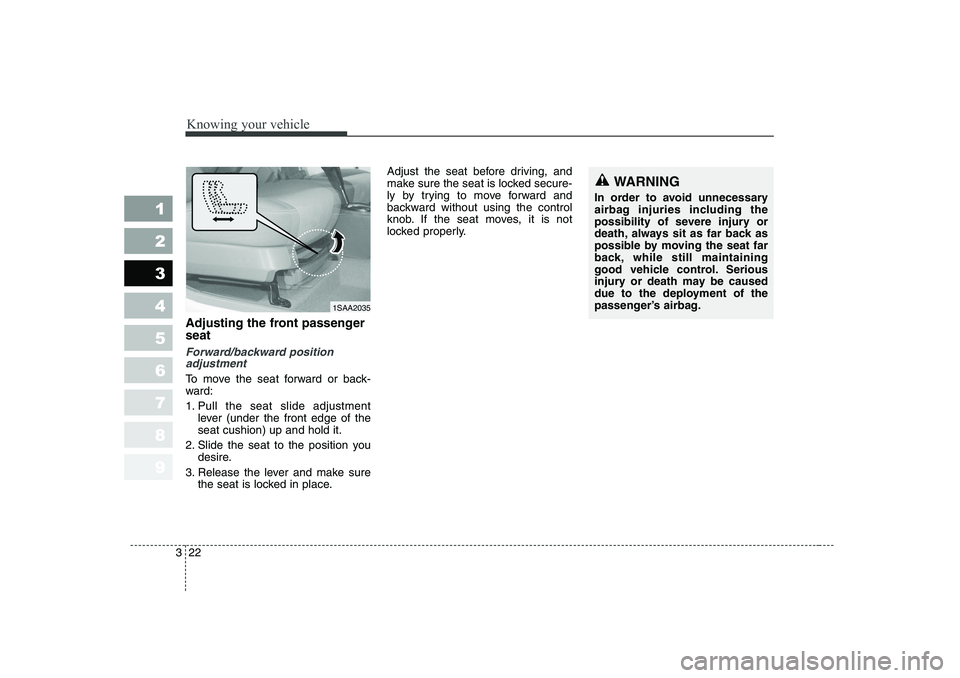
Knowing your vehicle
22
3
1 23456789
Adjusting the front passenger seat
Forward/backward position
adjustment
To move the seat forward or back-
ward:
1. Pull the seat slide adjustment
lever (under the front edge of the seat cushion) up and hold it.
2. Slide the seat to the position you desire.
3. Release the lever and make sure the seat is locked in place. Adjust the seat before driving, and
make sure the seat is locked secure-
ly by trying to move forward and
backward without using the control
knob. If the seat moves, it is not
locked properly.
WARNING
In order to avoid unnecessary
airbag injuries including the
possibility of severe injury or
death, always sit as far back as
possible by moving the seat far
back, while still maintaining
good vehicle control. Serious
injury or death may be caused
due to the deployment of the
passenger’s airbag.
1SAA2035
Page 33 of 281
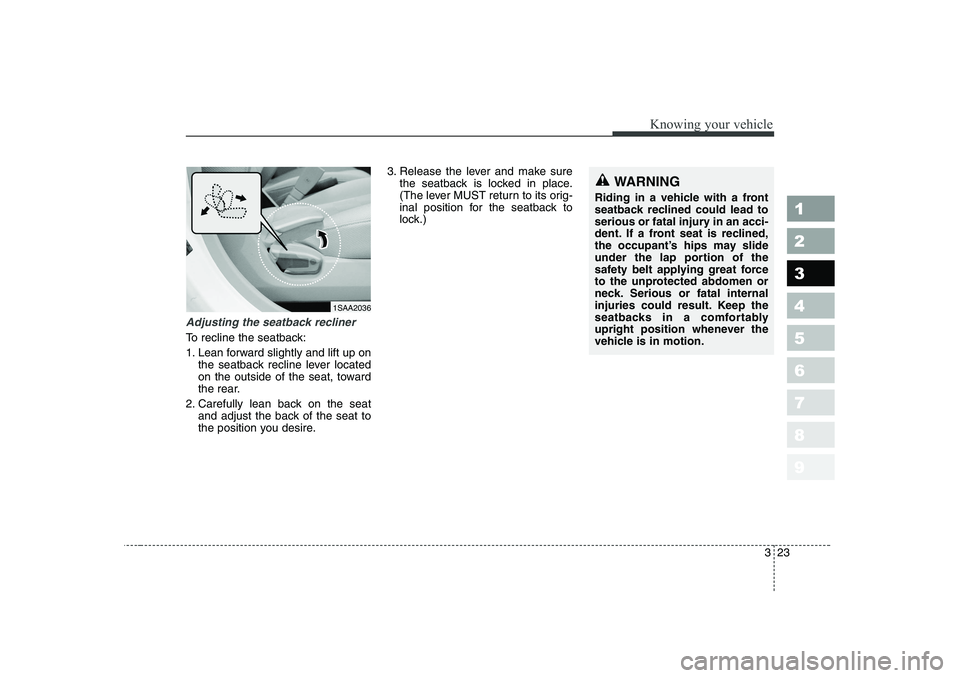
323
1 23456789
Knowing your vehicle
Adjusting the seatback recliner
To recline the seatback:
1. Lean forward slightly and lift up onthe seatback recline lever located
on the outside of the seat, toward
the rear.
2. Carefully lean back on the seat and adjust the back of the seat to
the position you desire. 3. Release the lever and make sure
the seatback is locked in place.
(The lever MUST return to its orig-
inal position for the seatback to
lock.)
WARNING
Riding in a vehicle with a front
seatback reclined could lead to
serious or fatal injury in an acci-
dent. If a front seat is reclined,
the occupant’s hips may slide
under the lap portion of the
safety belt applying great force
to the unprotected abdomen or
neck. Serious or fatal internal
injuries could result. Keep the
seatbacks in a comfortably
upright position whenever the
vehicle is in motion.
1SAA2036
Page 37 of 281
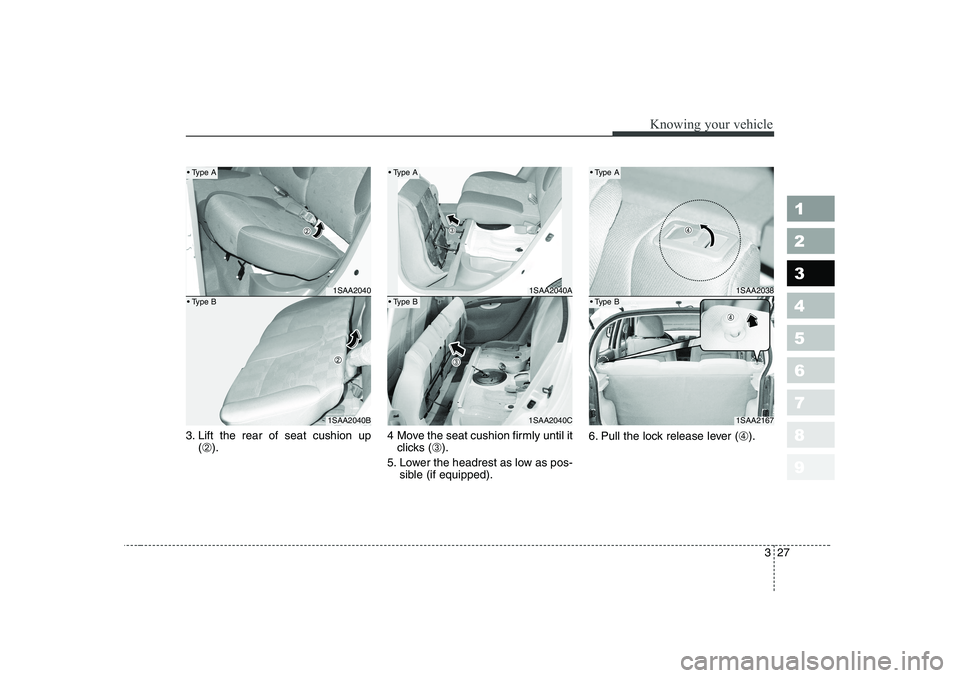
327
1 23456789
Knowing your vehicle
3. Lift the rear of seat cushion up(➁ ). 4 Move the seat cushion firmly until it
clicks ( ➂).
5. Lower the headrest as low as pos- sible (if equipped). 6. Pull the lock release lever (
➃).
1SAA2038
1SAA2167
1SAA2040A
1SAA2040C
1SAA2040
1SAA2040B
Type A
Type B
Type A
Type B
Type A
Type B
Page 40 of 281
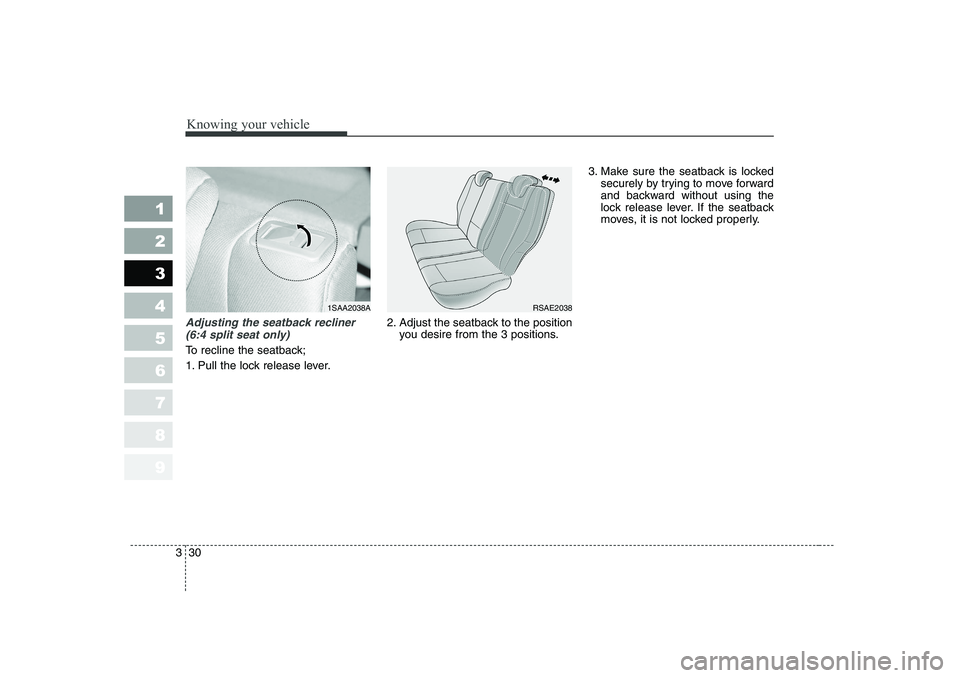
Knowing your vehicle
30
3
1 23456789
Adjusting the seatback recliner
(6:4 split seat only)
To recline the seatback;
1. Pull the lock release lever. 2. Adjust the seatback to the position
you desire from the 3 positions. 3. Make sure the seatback is locked
securely by trying to move forward
and backward without using the
lock release lever. If the seatback
moves, it is not locked properly.
1SAA2038ARSAE2038
Page 45 of 281
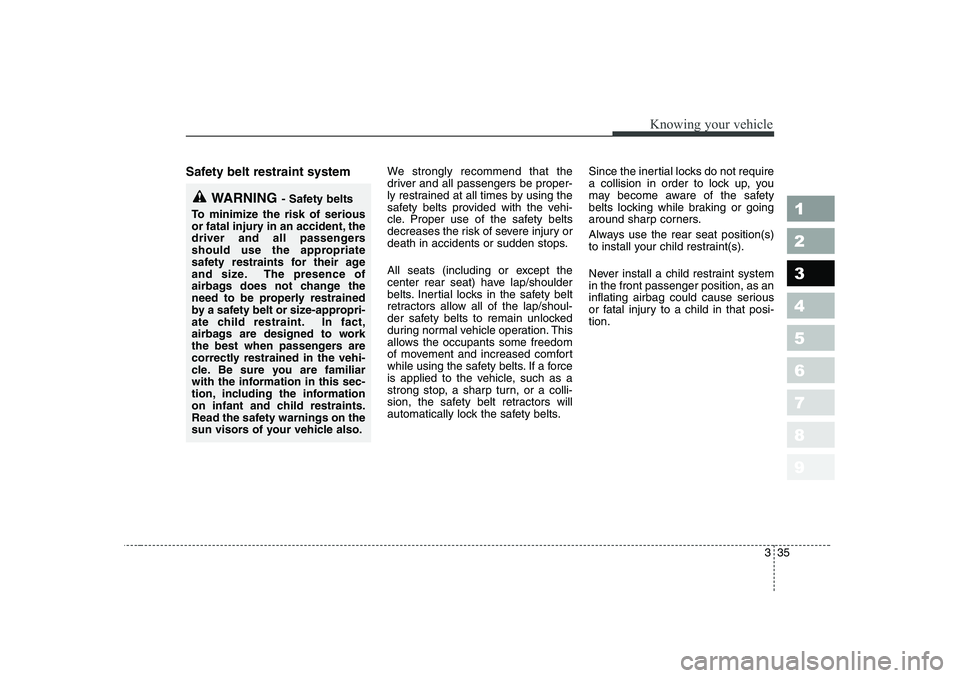
335
1 23456789
Knowing your vehicle
Safety belt restraint system We strongly recommend that the
driver and all passengers be proper-
ly restrained at all times by using the
safety belts provided with the vehi-
cle. Proper use of the safety belts
decreases the risk of severe injury or
death in accidents or sudden stops.
All seats (including or except the
center rear seat) have lap/shoulder
belts. Inertial locks in the safety belt
retractors allow all of the lap/shoul-
der safety belts to remain unlocked
during normal vehicle operation. This
allows the occupants some freedom
of movement and increased comfort
while using the safety belts. If a force
is applied to the vehicle, such as a
strong stop, a sharp turn, or a colli-
sion, the safety belt retractors will
automatically lock the safety belts.Since the inertial locks do not require
a collision in order to lock up, you
may become aware of the safety
belts locking while braking or going
around sharp corners.
Always use the rear seat position(s)
to install your child restraint(s).
Never install a child restraint system in the front passenger position, as an
inflating airbag could cause serious
or fatal injury to a child in that posi-tion.
WARNING
- Safety belts
To minimize the risk of serious
or fatal injury in an accident, the
driver and all passengers
should use the appropriate
safety restraints for their age
and size. The presence of
airbags does not change the
need to be properly restrained
by a safety belt or size-appropri-
ate child restraint. In fact,
airbags are designed to work
the best when passengers are
correctly restrained in the vehi-
cle. Be sure you are familiar
with the information in this sec-
tion, including the information
on infant and child restraints.
Read the safety warnings on the
sun visors of your vehicle also.